|
Why would anyone want to travel a Trail of Death? And to travel it five times - you would have to be crazy, right? A group of Potawatomi Indians and historians have done just that, every five years since 1988. They have traveled the 1838 Potawatomi Trail of Death from Indiana to Kansas to commemorate the Potawatomi and to preserve history, to help people understand today what really happened. They have created a Regional Historic Trail with 78 historical markers and many historic highway signs. This year they nearly completed the signage across Indiana. George Godfrey, my husband Bill and I collaborated to organize and lead the fifth Trail of Death Commemorative Caravan Sept. 22-27. We had a good time and met several Potawatomi who are newly interested in the Trail of Death, and made new contacts to help erect the historic highway signs for the “Potawatomi Trail of Death Regional Historic Trail.” It does not sound like 660 miles would be hard to travel on today’s roads but we were detoured by bridges ruined by floods, got lost once, and the usual missing of turns that characterize any trip. Even though Bill uses a Street-finder, it does not take you places unless you have a street name and number. So for the rural places, we had to go by maps we had printed out from the Internet. Most were accurate but sometimes maps do not match the street signs. I think there should be a law that street names cannot be changed because it causes troubles to mapmakers, map users, and people who have to change their addresses. To honor someone, name a building or a bridge, but please leave the streets and roads with their old names. “True West” magazine called to say they will publish a story about the Potawatomi Trail of Death. The magazine has a section called “Saviors of the Old West,” and my work to preserve the history of this historic trail will be featured in an upcoming issue. At one time Indiana was the western-most state. Since we got home from traveling on the Trail of Death caravan, I have been getting phone calls and emails daily from the caravan participants and people in the 26 counties we passed through. They have sent me photos and their thoughts and offers to help get the historic highway signs erected. We have traveled as a Trail of Death Commemorative Caravan every five years since 1988 and every time we learn more history. You might think all the history has been written but all has not even been discovered yet. In 2003 I was so excited, I could not sleep during the caravan. This time I was so tired after the Trail of Courage that at times I could barely keep awake. The Trail of Courage Living History Festival was great - perfect weather, warm and sunny, big crowd. The Trail of Death caravan had perfect weather too. It did not rain on us once. On the way back home Monday Sept. 29 we ran into rain but that was the first. Three Prairie Band Potawatomi traveled with us for the first time: Thomas Wabnum and 18- year- old son Marshall, Albuquerque, New Mexico, and his brother-in-law Edward J. (Eddie Joe) Mitchell, Mayetta, Kansas. They were lots of fun and inspiration. Eddie Joe has We-wiss-sa in his family tree, (We-wiss-sa is pictured in the George Winter book, which tells that his mother was 100 years old and died on the Trail of Death camped at Lafayette.) After I got back home and conferred with Melinda Clinger, I asked him to be the honored Potawatomi at the Trail of Courage next year. A couple of weeks later Eddie emailed me his acceptance. He makes drums and crafts so he will come to demonstrate and sell those items at the Trail of Courage. Others who traveled on the caravan were old Potawatomi friends: George Godfrey, Athens, Illinois; Susan Campbell, Kalaheo, Hawaii; Sister Virginia Pearl, Pawnee Rock, Kansas; Bob Pearl and daughter Janet, Parma Heights, Ohio; Theresa and Wayne McNary, Ozawkie, Kansas; Tom Hamilton, Warsaw, Indiana. Other new Potawatomi were Tom’s son Joe Hamilton, Warsaw; Tracy Locke and nine-year-old daughter Erin, Lafayette, Indiana; and Jon Boursaw, Tecumseh, Oklahoma. The Citizen Potawatomi Nation was awarded a grant to make a documentary about their history, so Boursaw and Leslie Gee were sent to video tape the Trail of Death. Persons interested in history also traveled with us for the first day: Valerie Berkshire, Kewanna, Indiana; and Mary Brady, Logansport, Indiana. Traveling with us for three days were J. R. Burger, Plymouth, Indiana; and Rich Meyers, Millersburg, Indiana. Susan Estall, Downers Grove, Illinois, went with the caravan the first three days and then had to go home, but she drove 9 hours to rejoin the caravan at Independence, Missouri. Joining the caravan in Quincy were Roy and Julie Slavin, Kansas City, Missouri; Dolores and Si Grizzell, Winamac, Indiana, and joining us at Independence, Missouri, were Marjorie Pearl Guerich and granddaughter Amy, St. Marys, Kansas. Roy Slavin and the Pearls are cousins and members of the Citizen Potawatomi Nation. Guides who led us across their section were Kevin Young, Danville, Illinois; Lester Florea, Monroe City, Missouri; Carol Baker and Cecil Abbott of Lexington, Missouri. Otherwise Bill and I and George Godfrey were the guides in the lead vehicles. 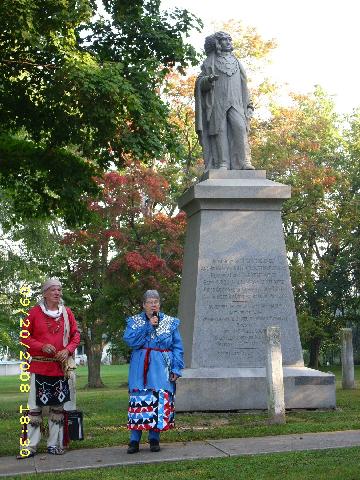 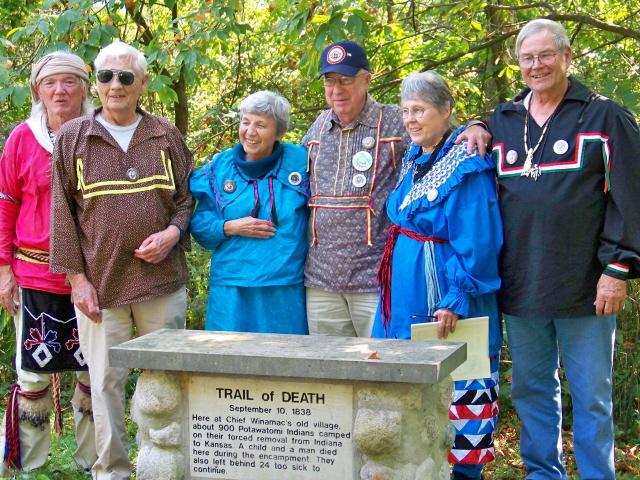 We began at Chief Menominee statue at Twin Lakes south of Plymouth. George and Michele Schricker sang their song “Menominee The Man Who Wouldn’t Sign” and Michele did the song in sign language. Plymouth Mayor Mark Senter greeted us, as did Linda Rippy of Marshall County Historical Society. Eddie Joe Mitchell, Prairie Band elder, said a prayer in Potawatomi. We gave all the people there a badge for the 2008 Trail of Death Commemorative Caravan with Abram Burnett’s picture on it. (Burnett was a full blood Potawatomi on the 1838 Trail of Death. A close friend of Father Petit, Burnett accompanied him to St. Louis where Petit died Feb. 10, 1839.) We gave badges to everyone at every stop all the way to Kansas. When leaving the Menominee statue, we followed the Trail of Death historic highway signs north to 12th Road and then east to the Michigan Road (Old 31) and south through Argos, stopping at the Tippecanoe River. This was the camp site for the first night of the 1838 journey, marked by a historical marker on a huge boulder placed by Manitou Chapter DAR in 1922. After a brief stop there, we came on to Rochester, stopping at the courthouse by the Trail of Death memorial on Main Street. Then we went south on Indiana 25, passing but not stopping at the Trail of Death marker at Mud Creek where the first death occurred. I used the CB radio and read from the Trail of Death diary as we drove by Mud Creek. At Logansport we ate lunch at Memorial Hospital cafeteria. In other years the caravan took a short cut through Logansport but this time we followed the Wabash River as they did in 1838. It was a pleasure and a real help to see the new Potawatomi Trail of Death Regional Historic Trail highway signs across Cass and Carroll counties. In 1838 the Potawatomi followed the Wabash River but did not cross it, and neither did we as we retraced the original route. Chief Winnemac’s (also spelled Chief Winamac) Old Village on the Towpath Road was the next stop. When we left there, we missed the Burnett Creek Arch and found ourselves at the next camp site at Pleasant Run near Pittsburg. Realizing our mistake, we backtracked about 10 miles to the Burnett Creek Arch where we all walked down behind the canal boat bridge to see the creek flowing under the stone arch built in 1838 or 40. The signs there give both dates. At Delphi we visited the Wabash & Erie Canal Center, hosted by Mark Smith. This is a beautiful place to see how the canal operated. Lafayette TV interviewed Tracy Locke and her little daughter Erin because they are descended from Abram Burnett who was on the Trail of Death. They have been trying to get permission from the Tippecanoe County Commissioners to erect Trail of Death historic highway signs across their county but so far have not gotten their permission. But when we entered Battle Ground, we saw the Trail of Death highway signs there, approved by their Town Board. As we traveled we had wonderful meals provided by local people at least once a day. At Lafayette the first night the National Center for Great Lakes Native American Culture cooked a supper for us of Native American foods: venison stew, pumpkin bread, squash casserole, venison wild rice, wild greens and nuts salad, tomatoes, strawberries and watermelon. The fellowship was good too. A reporter for the Lafayette Journal - Courier interviewed us. On Tuesday morning Sept. 23 we left Lafayette and started on the Trail of Death again. When we stopped to see the Trail of Death marker on the Tippecanoe - Warren county line, a donkey brayed at us very loudly for over a minute. It must have been startled by the group of cars and people who came to pet it. A very affectionate animal, the donkey laid its head on the visitors’ shoulders and when we left, it brayed long and loud again, to say good bye. We failed to turn at the right place when approaching Williamsport so we drove through the downtown and by the tallest water falls in Indiana. The Trail of Death marker is in a small park on Old Second Street about where the actual camp site of 1838 is believed to have been. In other years the caravan took a short cut across Warren County but this time we followed the Wabash River, following the Trail of Death historic highway signs. The Gopher Hill Cemetery is only two miles from the state line and has the last Trail of Death marker in Indiana. This old cemetery has the graves of two soldiers who died with General William Henry Harrison’s army when they returned from the Battle of Tippecanoe in 1811. Historian Kevin Young met us at Gopher Hill to lead us to Danville, Illinois. In 1838 General John Tipton’s power expired at the state line because he was appointed by Indiana Governor David Wallace. So William Polke of Rochester took over as the federal conductor. And Father Benjamin Petit caught up with them at Danville. Polke put Father Petit in charge of the sick. He said prayers and conducted funerals nearly every day from then on as they traveled 15 to 20 miles a day across Illinois and Missouri. 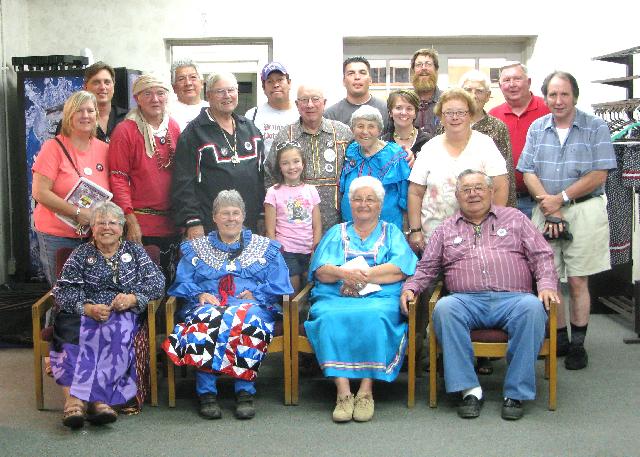 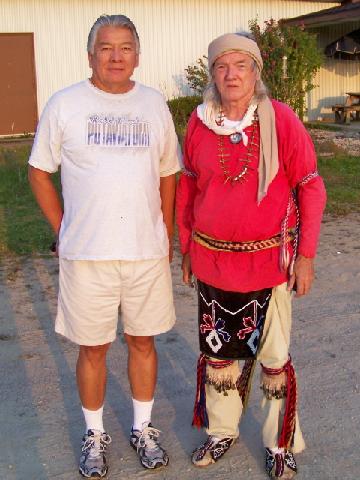 In Danville historian Kevin Young had found the site of the 1838 campsite at Turtle Run Golf Course. This is new history discovered so we covered ground never traveled by our caravans before. At Ellsworth Park, Paul Quick, a local Cherokee, served us box lunches from his son David’s restaurant. Quick erected the Trail of Death historical marker in Ellsworth Park in 1993. We drove by the Trail of Death historical markers at Catlin and Homer, and stopped at the Sidney and Sadorus markers. Unfortunately, we made wrong turns at least three times a day. After leaving Monticello, IL, George and I were in the lead vehicle with maps, and a bridge was out. So then we ended up on the wrong side of the river and never did find the Sangamon Crossing Trail of Death historical marker. We did not know how to get to Decatur, IL, but finally found it. The marker is in Mueller Park so we stopped and walked down the hill to see it close up. We drove slowly by the Trail of Death marker in Niantic town park. We had to detour around bridges that were out in more places. The floods earlier this summer did a lot of damage. This made us run about two hours late so we missed completely meeting the DAR ladies on the east edge of Springfield, where they erected a Trail of Death marker in 1995. That evening we ate at Hickory River Barbeque. We were joined by George and Pat Godfrey’s children and grandchildren. That night we had a meeting at Godfrey’s house but most were too tired to attend and went straight to their motel rooms. On Wednesday we began with a tour of the Old Capitol at Springfield, where Lincoln had served as both lawyer and in the legislature. A Trail of Death marker is in the plaza beside the Old Capitol telling that a workman on the construction of the capitol building in 1838 recorded in his journal that he saw the Indians passing through Springfield. The Sangamon County Historical Society presented us a plaque praising our work to preserve this historic trail. (You can see the plaque at the Fulton County Museum.) At the Old Salem Church we visited the Trail of Death marker and noticed a new marker by the big tree stating that General Ulysses S. Grant sat on a limb there to think. There was another marker about Grant and his Army being there in 1861, and we were familiar with it as it was there before our Trail of Death marker was erected. At Jacksonville, a group of people including Morgan County Historical Society officers, a man in a wheelchair and a newspaper reporter were waiting to see us when we arrived at the Trail of Death marker in Foreman Park. They led us to the Town Square where in 1838 the Potawatomi were led by the town band around the square and given gifts of food and tobacco. In previous years the high school band played for our caravan. No band greeted us this year but several friendly people did. A bridge was out so we had to detour and miss the next Trail of Death marker. We drove through Exeter but decided not to go to Naples because of flooding earlier this summer and because we were running late. We had to drive to Meredocia to go on the big bridge over the Illinois River. At 2 p.m. we had a wonderful dinner at Perry, IL, cooked by the families of the Mountain brothers, Dean Bill and Wayne, who had Potawatomi ancestors. A brief stop at Liberty allowed the “Liberty Bee-News” reporter to take our picture. We were on time entering Quincy for Mass in the St. Boniface Church where the Potawatomi had Mass in 1838. Then we had a big picnic sponsored by Steve Tieken’s group, North American Archaeological Institute. Gifts were presented to each caravan member of tobacco and a turkey feather, and children gave us each a vegetable such as potato or carrot to symbolize feeding the Potawatomi in 1838. They also gave a red rose to the ladies and a box of four chocolates to the men. The Assistant Mayor of Quincy presented a Key to the City to the caravan. The local TV station was there. Steve had arranged for us to sleep as guests in big mansions on Maine Street. It was like being in “Antiques Road Show”. Fantastic! 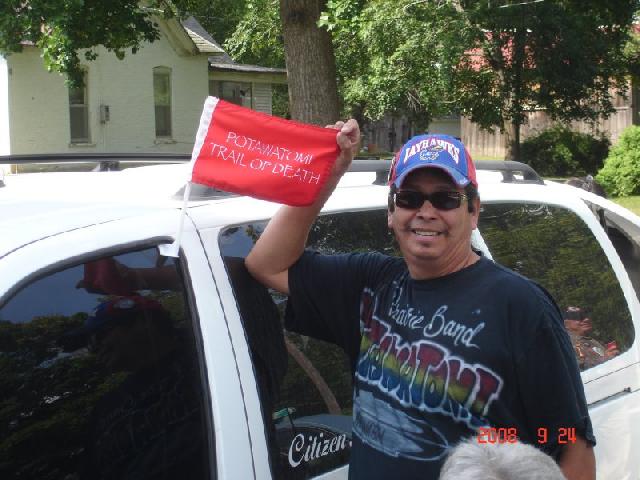 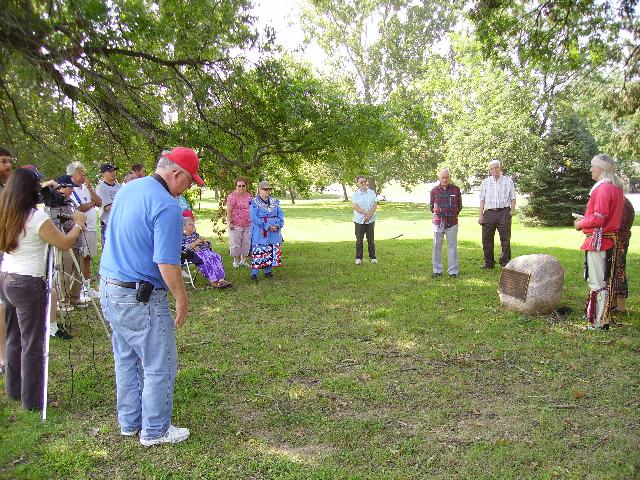 When the Potawatomi crossed the mighty Mississippi River in 1838, it took two days to ferry them and the wagons across on a steam ferryboat. We crossed in a couple of minutes on the new bridge, built after the big flood of 1993. Thus we entered Missouri. The Trail of Death marker in West Quincy is by a gas station. This was where they camped two days while ferrying the wagons across the wide river. On we went to Palmyra, the campsite for the second night in Missouri. The Palmyra Heritage Seekers paid for our breakfast at Hardee’s. There is a Trail of Death plaque on a boulder by the restaurant door. We also visited the Trail of Death marker near Palmyra where the actual camp site was. Visiting Josephine Gander’s farm house was one of the highlights of the trip. From her front porch we sat and sipped iced tea and munched on cookies as we gazed on the abandoned road on which the Potawatomi walked in 1838. Josephine is 92 years old and when asked how she is, answers she is “feeling no pain.” She is such a blessing! She and her husband sponsored three Trail of Death historical markers several years ago. The next marker was at the Mt. Vernon Methodist Church near Gander’s farm. Another bridge out caused us to detour to the next marker at North Fork of the Salt River. Gander’s neighbor Lester Florea guided us. At Paris, MO, the Trail of Death marker is in front of the courthouse. The county judge came out to welcome us. Then we visited the museum in the courthouse. We walked a couple of blocks and ate lunch at Jonsey’s Restaurant. We visited the County Historical Society’s Archives in the old high school, which they turned into a research center. The next Trail of Death marker is at Hutsell Rest Park east of Moberly. This is the marker sponsored by Dolores Grizzell, Winamac, Indiana. We visited the Randolph County Museum in Moberly. General Omar Bradley of World War II was born there. That night the Randolph County and Huntsville historical societies fed us at the library. It was a relaxing time of telling jokes, as well as sharing history. Thomas Wabnum, a Prairie Band Potawatomi traveling with us, gave us copies of George Catlin’s Creed. He also gave us Green Lemonade recipe. He said he has been drinking it and no longer has diabetes. You can find it on the Internet. Friday found us crossing Missouri on Old 24. We missed the turn to Huntsville but we stopped at Salisbury to video tape reading the diary. At Keytesville we recalled that in 1988 Bill Wamego sang the “Cabbage Head” song to entertain the group at supper in the town hall. (Wamego died in 1993.) We stopped at the James Pecan Farm but it was closed because they had no pecan crop last year. We called Sandy James Naylor on cell phone and she said they will have a bumper crop of pecans this year. At Brunswick the Trail of Death marker is a tombstone flat on the ground so they had to put a big Historical Marker sign by it. It is at a boat ramp on the Grand River. There we met Don and Mary Riddle, who said the river floods and gets the marker muddy so we suggested they put a riser under it so it will be three feet above ground level DeWitt Youth Group mothers, led by Anita Brown and Darlene Link, served us a midmorning snack of rolls, brownies, coffee and juice. One of the ladies had made the most delicious yeast rolls, iced and fresh from the oven. Ummmm. Moving on to Carrollton and Richmond, we stopped at both Trail of Death markers, took pictures and went on. The marker at Richmond is beside the high school and had dead grass on top so we had to rake it off with our hands. The principal came out and said he would tell the man who mows to keep the marker clean. The Lexington Chamber of Commerce director, Carol Baker, met us for lunch at Sommerset Cottage. We took pictures of our Trail of Death marker by the huge Madonna of the Trail statue. Then Carol guided us (in a white Corvette driven by a Cherokee, Cecil Abbott) through the small towns of Wellington and Napoleon. We had to pass by the Buckner and Lake City Trail of Death markers in order to keep to our schedule. When we arrived in Independence, we had a surprise. A mule team with a covered wagon was giving rides, so several of us climbed on and paid $7 each for a 20 minute tour. The mule driver was Cherokee and told us marvelous stories about Wild Bill Hickok and others who were there in the old days. We toured the Jackson County Museum, which is the old jail where outlaw Frank James was held after his surrender. All very interesting! Susan Campbell revealed to me that William Quantrill, Civil War raider and outlaw, was one of her ancestors. The dedication of the new marker at Independence was inspiring. The Trail of Death marker placed by Boy Scout Matt Moreno in 1993 had been hit by a city mower and broken. So the city paid for a new marker, erected this year by Matt’s nephew, Jason King, who earned his Eagle Scout award with this project. Peggy Kinder, Citizen Potawatomi Nation member, brought her husband and friends to play the drum and she danced on the circle of bricks beside the log cabin museum at Pioneer Spring Park on Truman and Noland roads. Several of us danced too. Peggy is descended from Daniel Bourassa, the first Potawatomi recorded on the Trail of Death muster roll. She and her twin sons and husband danced at the Trail of Courage in 1996, as the honored Potawatomi family. Later we gathered to eat at the Courthouse Exchange restaurant in Independence. The next morning we saw ourselves on TV at the dedication the night before. Our first stop was Grandview, MO, where we were glad to see the Trail of Death historical marker had finally been erected. Boy Scouts had gotten the stone engraved in 2000 but it was not erected until permission from the local parks department was obtained and then they had to get new Boy Scouts because the others had grown up and moved on. But Charlie Hasenyager, retired Scout Master, hung in there and got it done last year by two brothers, Ben and Jake Fichman, now Eagle Scouts. 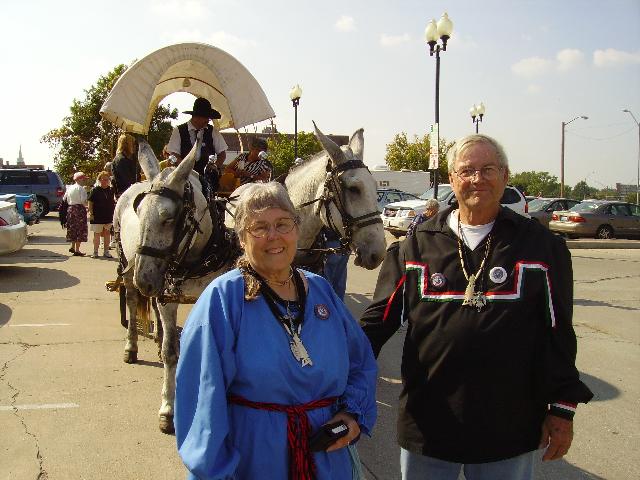 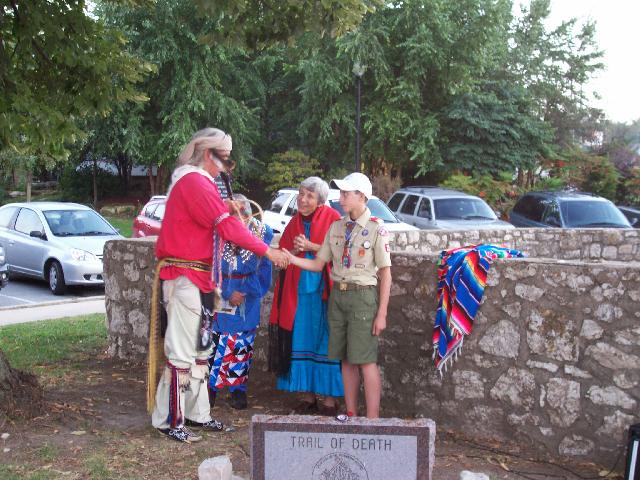 The first Trail of Death marker in Kansas is on the state line. Sad to say, it was grown up with weeds and barely visible from the road. At Paola, Kansas, the Trail of Death marker is in the town square park. We ate at Beethoven’s Restaurant for lunch. They have the world’s best chocolate chip cookies - I kid you not! I love chocolate chip cookies and these are the biggest with the most chips I have ever seen. Miami County Historical Society welcomed us and gave us a bag of brochures and a Kansas map. That was good because we needed that map later in the day. We visited their museum and saw artifacts from the Sugar Creek Museum where the Potawatomi lived 1838 -1848. They gave us old rusty square-head nails from the log buildings erected 170 years ago at the mission. In Osawatomie we stopped at the Trail of Death marker beside the Old Land Office and a marker for John Brown of Civil War fame. When we arrived at Sugar Creek Mission, Linn County Historical Society president Ola May Ernest and friends served apples, cookies, iced tea and lemonade for us mid-afternoon. We concluded our journey there and during the closing ceremony I recalled that five years ago they had adopted Bill and me and showed the pictures taken at that time. I told them it was the greatest honor in our lives and we love the Potawatomi, who are very kind and loving. Jon Boursaw and Leslie Gee, representing the Citizen Potawatomi Nation, did video taping all the way for a documentary on the Trail of Death. They were kind and loving too, as were all the people on the caravan. Then we went on to Lawrence, Kansas, to Jamison Bear’s where they had prepared a traditional feast of fry bread, meat gravy, dried corn soup, Indian hominy, grape dumplings, and four kinds of fruit cobblers. The food was cooked by Jamison’s wife Raelene and her sisters Lori Morgan and Michele Lasley (all Osage tribal members) and friend Cathy Franklin (Cheyenne tribe). We sat at tables outside under the trees and heard the locusts sing. It was a beautiful night. We said good bye to the group and went our separate directions. Just to show how close the group had gotten, Marshall Wabnum, age 18, came to me and said they were going home to Mayetta but would meet us for breakfast the next morning in Kansas City. But I told him everyone was going their separate directions and there would be no group breakfast the next morning. Everybody hugged and wished each a safe trip home. Only Bill and me, Bob and Janet Pearl went to Lawrence to a motel. The next day Bill and I drove to our son Tom’s house near St. Louis and spent the night there. Sept. 28 was my 72nd birthday so Tom’s wife Debbie had a birthday cake for me and we got to meet our granddaughter Meaghan’s new boyfriend. When I got home, “News From Indian Country” had emailed a request that I write a story about the trip. I was just too exhausted to even think about it and still had to finish the Manitou Chapter DAR history, so I asked Susan Campbell if she would do it. She said yes. It is hard to summarize our journey, a week of traveling and experiencing so many surprises along the way. Nothing mystic or miraculous happened this time, like on the other caravans. It was a time of serious reflection, lots of laughter, close fellowship and prayer. J. R. Burger read from the Bible and Eddie Joe Mitchell said prayers in Potawatomi. We were on television at Lafayette, Quincy and Kansas City. Many newspaper reporters came out to take our picture and interview the caravan. Most of the articles are available on the Internet, even the TV videos. You can see us at Independence on You Tube under “Boy Scout fixes Trail of Death marker.” We are glad that the Potawatomi Trail of Death is getting the historical recognition it deserves. For many years it has been “swept under the rug of history,” half forgotten and ignored. The Trail of Death was a terrible thing and you know the old saying: “If history is forgotten, it is likely to be repeated.” We are continuing to push our project of erecting historic highway signs across the four states so that travelers can follow the Trail of Death. We got Indiana completed, except for some of the signs in Tippecanoe County. We got money donated for 10 signs in Quincy, so I ordered them shipped to Steve Tieken, who will get them erected and work on getting more donated to complete his county. Wayne Johnson of the Miami County Historical Society, Paola, Kansas, and Ola May Earnest of Linn County Historical Society are working to get permission and the signs erected in their county, and so is the Chamber of Commerce in Lexington, Missouri, with signs sponsored by the Citizen Potawatomi Nation. The township board of Danville, Illinois, offered to sponsor signs across their township. Will we go again in 2013? Only God knows. Many of the people who traveled on the caravan with us in previous years have passed away. Looking back at the first caravan in 1988, we see that 13 of them have died. So we are looking for younger people to plan and lead the caravan next time. We are happy to see several younger folks taking an interest this year. 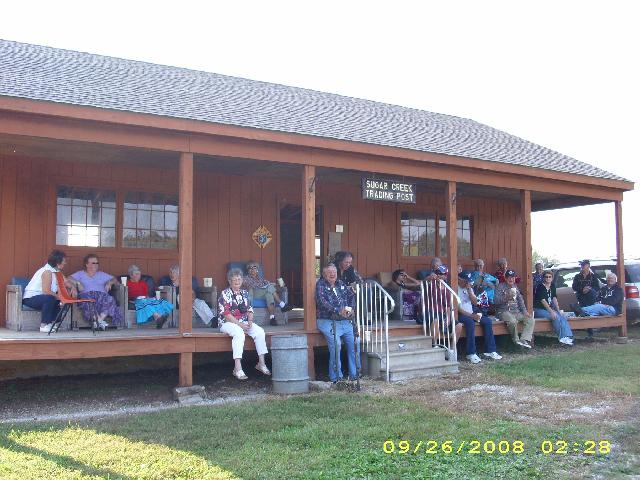 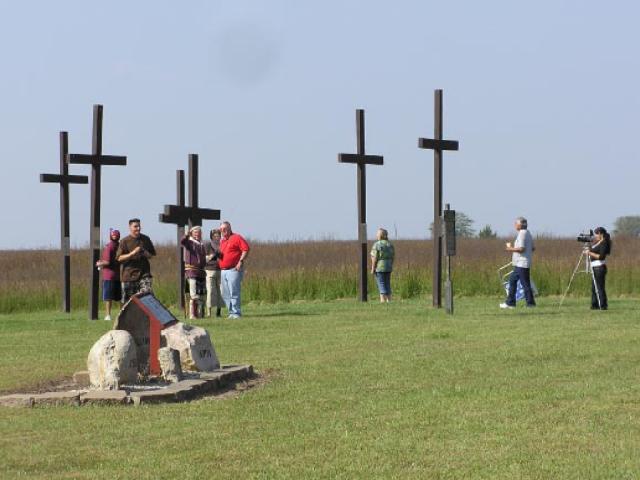 Sept. 22 Monday 8 a.m. meet at Fulton County Museum to get organized; ceremony at 9 a.m. at Chief Menominee statue south of Plymouth. Stop at Trail of Death historical markers by Rochester, follow Trail of Death through Fulton, eat lunch at Logansport Hospital cafeteria, follow Trail of Death through Georgetown and Pittsburg. Visit Wabash & Erie Canal Center at Delphi at 4 p.m.; continue through Battle Ground and Lafayette, eat supper at 6 p.m. at Tippecanoe Arts Federation, 638 North St., Lafayette, compliments of the National Center of Great Lakes Native American Culture, Portland, IN. Spend the night at Super 8 Motel in Lafayette, Indiana. Sept. 23 Tuesday, breakfast in motel. Follow Trail of Death through Lafayette, Independence, Williamsport, & Gopher Hill. Box lunch at Danville, IL in Elsworth Park - compliments of Charlotte’s Restaurant, owned by David Quick, whose father Paul Quick erected the Trail of Death marker in 1993. Follow Trail of Death through Catlin, Sidney, Sidorus, Monticello, Decatur, Niantic, and Springfield. Supper at Hickory Creek Barbecue. Evening meeting at George Godfrey’s house at Athens, spend night at Super 8 Motel in Springfield, IL. Sept. 24 Wednesday, breakfast in motel. Tour Old Capitol Building in Springfield at 8:30 a.m., see Trail of Death marker there. Follow Trail of Death through Jacksonville and Exeter. Eat lunch at church in Perry - compliments of Mountain family. Continue following Trail of Death through Liberty. Mass at St. Mary’s Church in Quincy at 4 p.m. Community supper at Quinsippi Island, spend night at private homes in Quincy, IL. Sept. 25 Thursday, cross Mississippi River to West Quincy, MO, breakfast at 9 a.m. in Hardee’s in Palmyra, MO - compliments of Heritage Seekers. Visit Josephine Gander farm, follow Trail of Death through country to eat lunch in Jonsey’s restaurant in Paris, visit Paris museum and research center, visit Randolph County Museum, supper 6 p.m. in Moberly Library, provided by Huntsville and Randolph County historical societies. Spend night at Super 8 Motel in Moberly, MO. Sept. 26 Friday, breakfast at motel. Follow Trail of Death through Huntsville, Salisbury, Keytesville, & Brunswick. Mid-morning refreshments at DeWitt community center. Continue through Carrollton and Richmond. Eat lunch at Lexington in Sommerset Cottage with Chamber of Commerce director, continue on through Wellington & Napoleon. Visit Jackson County Museum at 3 p.m. Dedicate historical marker at Pioneer Spring Park in Independence at 6:30 p.m. Eat supper at 7:30 p. m. in Court House Exchange restaurant, 113 W. Lexington Ave., Independence. Spend night at Super 8 Motel in Independence, MO. Sept. 27 Saturday, breakfast in motel. Follow Trail of Death through Grandview, Mo., eat lunch at Paola in Beethoven’s restaurant. Follow Trail of Death through Osawatomie, KS, Sugar Creek Mission in rural Linn County, KS, then on to Lawrence, KS. Jamison Bear (Osage from Lawrence, former Haskell faculty member, and good friend) said that his wife and sister-in-law will prepare a supper - fry bread, dumplings, etc.....(it was traditional and GOOD!) for the caravan when it got to Lawrence. Farewell to all as they headed different directions toward home. |
| < Previous | Home | Next > |